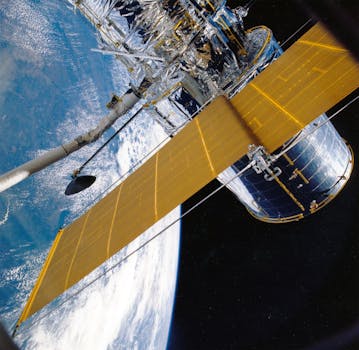GEO Satellites: Understanding the Technology and Applications of Geostationary Orbit Satellites

GEO Satellites: Introduction to Geostationary Orbit Satellites
GEO satellites, or geostationary orbit satellites, are a type of satellite that orbits the Earth at an altitude of approximately 36,000 kilometers above the equator. At this height, the satellite’s orbital period matches the Earth’s rotational period, allowing it to remain stationary relative to a fixed point on the Earth’s surface. This unique characteristic makes GEO satellites ideal for a range of applications, including telecommunications, navigation, and weather forecasting.
The concept of geostationary orbit was first proposed by science fiction writer Arthur C. Clarke in 1945. However, it wasn’t until the launch of the first geostationary satellite, Syncom 2, in 1963 that the technology began to take shape. Since then, hundreds of GEO satellites have been launched, providing critical services to industries and governments around the world.
Design and Technology of GEO Satellites
GEO satellites are designed to operate in the harsh environment of space, where radiation, extreme temperatures, and debris pose significant challenges. To overcome these hurdles, GEO satellites are built with robust materials and equipped with advanced systems for power generation, propulsion, and communication.
The typical design of a GEO satellite consists of a rectangular or cylindrical body, with solar panels and antennas attached to the exterior. The satellite’s payload, which includes the communication equipment, navigation instruments, or weather sensors, is housed within the main body. The satellite’s power system, usually consisting of solar panels and batteries, provides the energy needed to operate the payload and maintain the satellite’s position in orbit.
One of the key challenges in designing GEO satellites is ensuring their stability and accuracy. To achieve this, satellites are equipped with advanced propulsion systems, such as ion thrusters or hall effect thrusters, which allow for precise adjustments to their orbit and attitude. Additionally, GEO satellites often employ sophisticated navigation systems, including GPS and star trackers, to maintain their position and orientation in space.
Applications of GEO Satellites
GEO satellites have a wide range of applications, from telecommunications and navigation to weather forecasting and Earth observation. In the telecommunications sector, GEO satellites provide critical infrastructure for broadcasting, mobile communications, and internet connectivity. Companies like Intelsat, SES, and Telesat operate large fleets of GEO satellites, offering services such as satellite TV, broadband internet, and mobile backhaul.
In the field of navigation, GEO satellites play a vital role in providing location information and timing signals. The Global Positioning System (GPS), operated by the US Department of Defense, relies on a constellation of 24-32 satellites in medium Earth orbit, but GEO satellites like the European Union’s Galileo system and the Russian GLONASS system also contribute to global navigation capabilities.
Weather forecasting is another critical application of GEO satellites. Satellites like the Geostationary Operational Environmental Satellite (GOES) series, operated by the US National Oceanic and Atmospheric Administration (NOAA), provide high-resolution imagery and data on atmospheric conditions, allowing meteorologists to track storms, monitor climate patterns, and predict weather events.
Future Developments and Challenges in GEO Satellites
As the demand for satellite services continues to grow, the GEO satellite industry is poised for significant expansion and innovation. New technologies, such as advanced propulsion systems, more efficient solar panels, and cutting-edge communication equipment, are being developed to improve the performance and lifespan of GEO satellites.
However, the GEO satellite industry also faces significant challenges, including the increasing risk of space debris, regulatory hurdles, and the need for more sustainable and environmentally friendly practices. As the number of satellites in orbit grows, the risk of collisions and interference between satellites increases, highlighting the need for more effective debris mitigation and removal strategies.
Furthermore, the GEO satellite industry must adapt to changing regulatory environments and evolving user needs. The development of new satellite constellations, such as the proposed Amazon Kuiper Systems and SpaceX’s Starlink, is expected to further transform the satellite landscape, offering new opportunities for innovation and growth.






